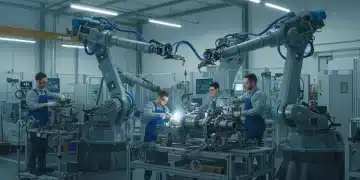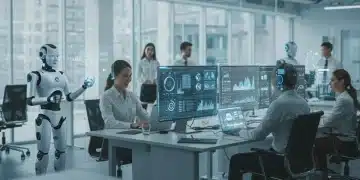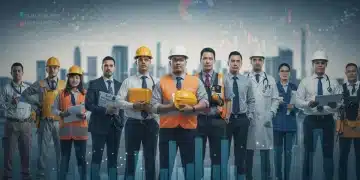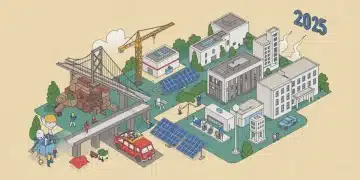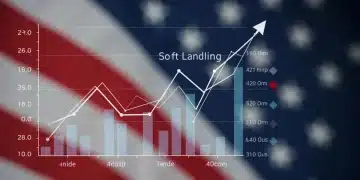Automation’s Impact: Job Displacement & US Economy by 2030
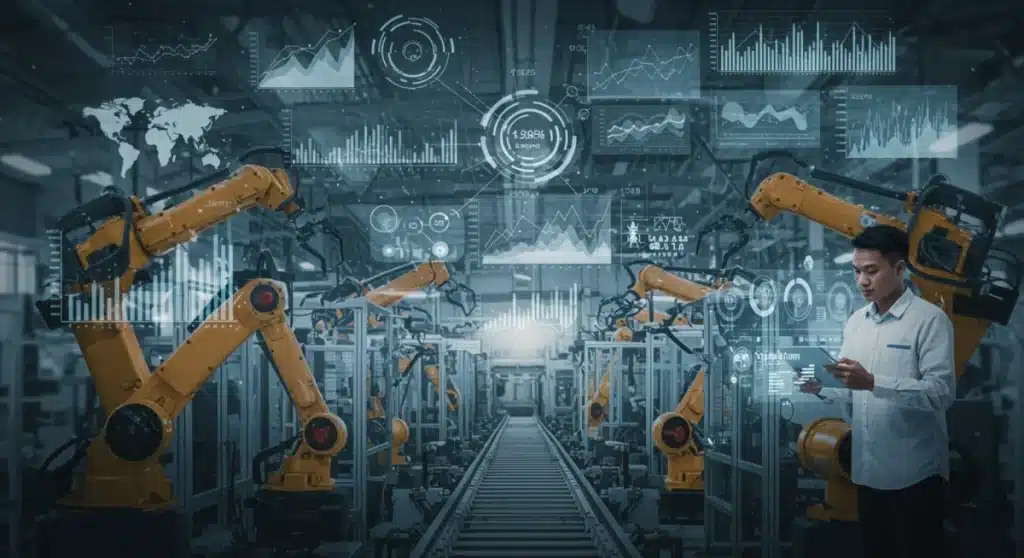
The profound impact of automation on job displacement and the US economy by 2030 necessitates strategic adaptations in education, workforce development, and public policy to navigate evolving labor market dynamics and foster inclusive growth.
The relentless march of technological innovation, particularly in artificial intelligence and robotics, has brought the topic of the impact of automation on job displacement and the US economy by 2030 to the forefront of national discourse. As machines become increasingly capable of performing tasks once exclusive to humans, questions arise about the future of work, economic stability, and societal well-being. This article delves into the multifaceted challenges and opportunities presented by this transformative era, exploring how industries, workers, and policymakers are preparing for a future defined by intelligent machines.
Understanding the Scope of Automation by 2030
By 2030, automation is projected to permeate nearly every sector of the US economy, driven by advancements in machine learning, robotics, and data analytics. This isn’t merely about replacing manual labor; it extends to cognitive tasks, data processing, and even creative endeavors. The scope of this transformation is vast, touching everything from manufacturing and logistics to healthcare and finance.
The integration of automation technologies is not uniform across all industries. Some sectors, like manufacturing and transportation, are already experiencing significant shifts, while others, such as highly specialized professional services, are just beginning to feel the effects. Understanding these nuances is crucial for predicting where job displacement will occur most acutely and where new opportunities will emerge.
Key Technological Drivers
Several technological advancements are fueling the automation revolution. These drivers include sophisticated algorithms, enhanced sensor technologies, and the increasing affordability of robotic systems. Each plays a critical role in expanding the capabilities of automated systems.
- Artificial Intelligence (AI): AI enables machines to learn from data, recognize patterns, and make decisions, moving beyond programmed instructions.
- Robotics: Advanced robotics allows for physical tasks to be performed with precision, speed, and endurance far exceeding human capabilities.
- Machine Learning (ML): A subset of AI, ML powers systems to improve performance over time without explicit programming, leading to greater adaptability.
- Internet of Things (IoT): IoT devices provide vast amounts of data that feed into AI systems, allowing for more intelligent and responsive automation.
These technologies are converging to create increasingly autonomous systems that can operate with minimal human intervention. This integration is accelerating the pace of change, making it imperative for the US to adapt quickly.
The widespread adoption of these technologies signifies a paradigm shift, moving from simple mechanization to intelligent automation. This evolution impacts not only the types of jobs available but also the skills required to perform them. Preparing for this future involves a deep understanding of these technological underpinnings and their potential societal implications.
Job Displacement: Sectors and Occupations at Risk
One of the most frequently discussed consequences of automation is job displacement. While automation often leads to increased efficiency and productivity, it can also render certain job roles obsolete. Identifying the sectors and occupations most susceptible to this displacement is essential for proactive policy-making and workforce planning.
Studies from various economic research institutions suggest that routine, repetitive tasks, whether manual or cognitive, are at the highest risk. This includes assembly line workers, data entry clerks, and even some administrative roles. However, the impact is not limited to blue-collar jobs; white-collar professions are also increasingly facing automation pressures.
Vulnerable Industries and Roles
Several industries are particularly vulnerable to significant job displacement by 2030 due to automation. These include sectors characterized by highly structured environments and predictable tasks. The nature of work in these areas makes them prime candidates for automation.
- Manufacturing: Robotic automation continues to replace human labor in assembly, welding, and quality control.
- Transportation and Logistics: Self-driving vehicles and automated warehouse systems threaten jobs for truck drivers, delivery personnel, and warehouse workers.
- Administrative Support: AI-powered software can handle tasks like scheduling, data processing, and customer service, impacting administrative assistants and call center agents.
- Retail: Automated checkout systems, inventory management, and online shopping reduce the need for sales associates and cashiers.
The impact within these industries can be profound, leading to significant shifts in employment patterns. While some jobs may be lost entirely, others will be redefined, requiring new skill sets and responsibilities. This transformation necessitates a strategic approach to education and training.
Beyond these industries, even professions traditionally considered safe, like accounting and legal services, are seeing parts of their work automated. AI can now perform tasks such as document review, data analysis, and legal research with greater speed and accuracy than humans. This highlights the broad reach of automation’s influence across the economy.
Emerging Opportunities: New Jobs and Skill Requirements
While job displacement is a significant concern, automation also acts as a powerful catalyst for the creation of new jobs and demands for new skills. History shows that technological revolutions, while disruptive, ultimately lead to economic growth and new forms of employment. The automation era is no different, presenting a wealth of opportunities for those prepared to adapt.
The jobs of the future will increasingly require skills that complement automation, rather than compete with it. These include critical thinking, creativity, emotional intelligence, and complex problem-solving. Roles focused on developing, deploying, maintaining, and supervising automated systems will also see significant growth.
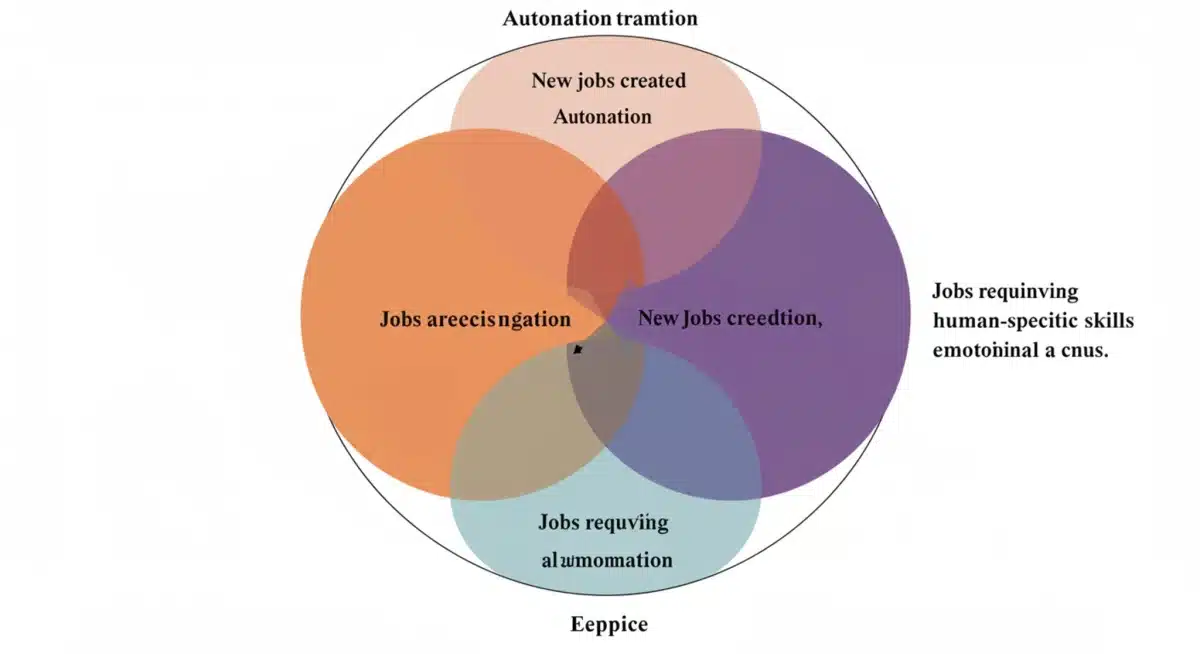
Growth Areas and Essential Skills
Several new job categories are expected to emerge or expand significantly in response to automation. These roles often combine technical expertise with uniquely human capabilities, creating a synergistic relationship with technology. Identifying these growth areas is key for individuals and educational institutions.
- AI and Machine Learning Engineers: Designing, developing, and implementing AI algorithms and systems.
- Robotics Technicians: Installing, maintaining, and repairing robotic systems in various industries.
- Data Scientists and Analysts: Interpreting the vast amounts of data generated by automated systems to derive insights.
- Cybersecurity Specialists: Protecting automated systems and data from cyber threats.
- Automation Ethics and Policy Experts: Addressing the societal and ethical implications of widespread automation.
Beyond these technical roles, there will also be an increased demand for jobs requiring interpersonal skills, creativity, and strategic thinking. Professions in education, healthcare, arts, and management are likely to see growth as human interaction and specialized judgment become even more valuable.
The shift towards an automated economy underscores the importance of lifelong learning and continuous skill development. Workers will need to be agile and adaptable, willing to acquire new competencies throughout their careers to remain relevant and competitive in a rapidly evolving job market. This proactive mindset is crucial for navigating the future of work.
Economic Implications for the US by 2030
The economic implications of widespread automation for the US by 2030 are profound and multifaceted. While automation promises increased productivity, economic growth, and potentially higher living standards, it also brings challenges related to income inequality, workforce transition costs, and the distribution of wealth. Navigating these complexities will be critical for sustained national prosperity.
Increased productivity from automation can lead to a more competitive economy, lower production costs, and potentially new goods and services. However, if the benefits of this productivity are not broadly shared, it could exacerbate existing economic disparities, leading to social and political unrest. Policymakers face the delicate task of balancing innovation with equity.
Productivity, Growth, and Inequality
Automation’s immediate impact on the economy often manifests as enhanced productivity. Companies can produce more with fewer resources, leading to higher output and potentially greater profits. This can drive overall economic growth, but the distribution of this growth is a key concern.
- Increased Productivity: Automated systems can operate 24/7 with minimal errors, boosting output significantly.
- Economic Growth: Higher productivity can translate into a stronger GDP and improved international competitiveness.
- Income Inequality: If automation primarily benefits capital owners and highly skilled workers, it could widen the gap between the rich and the poor.
- Consumer Benefits: Lower production costs can lead to more affordable goods and services for consumers.
Addressing potential increases in income inequality will require innovative policy solutions, such as adjustments to tax systems, robust social safety nets, and investments in education and training programs. The goal is to ensure that the economic gains from automation are shared across all segments of society, fostering inclusive growth.
Furthermore, the transition period itself could incur significant economic costs, including unemployment benefits for displaced workers, retraining program expenses, and potential social service expansions. Proactive planning and investment in these areas are essential to mitigate adverse effects and ensure a smoother economic transformation.
Policy Responses and Workforce Development Strategies
To effectively manage the impact of automation on job displacement and the US economy by 2030, robust policy responses and comprehensive workforce development strategies are indispensable. Governments, educational institutions, and businesses must collaborate to prepare the current and future workforce for the demands of an automated world. This requires foresight, flexibility, and significant investment.
One of the primary goals of these strategies should be to minimize the human cost of job displacement while maximizing the economic benefits of automation. This involves not only retraining individuals for new roles but also fostering a culture of continuous learning and adaptability throughout their careers.
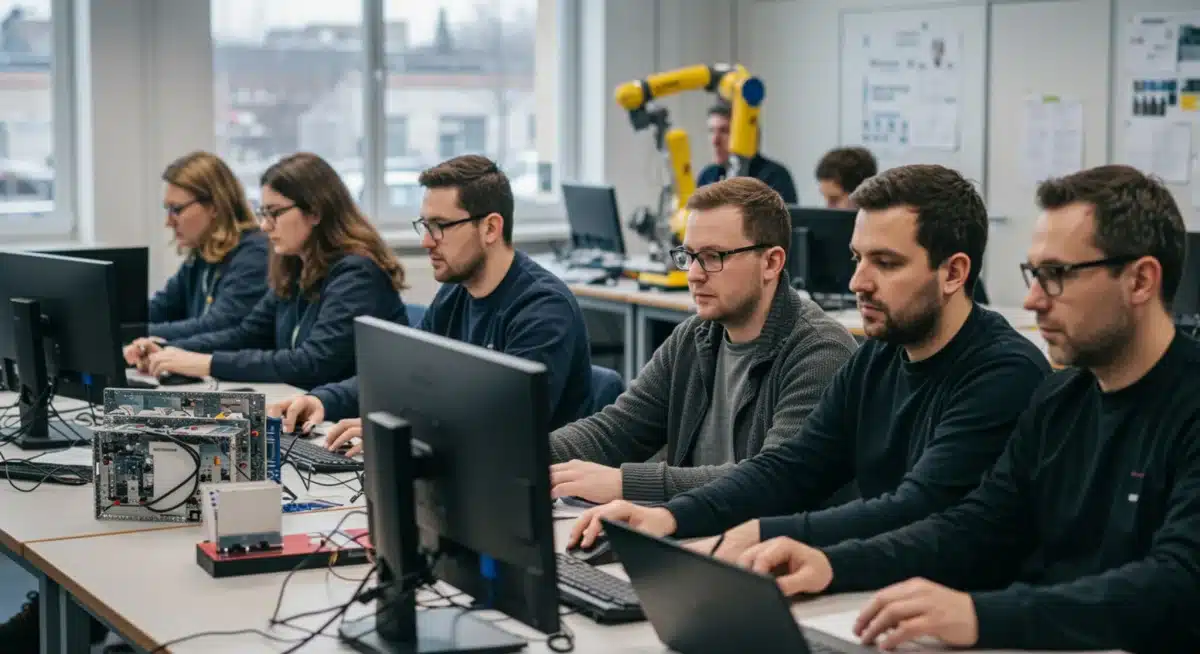
Key Strategies for Adaptation
Various strategies can be employed to help the US workforce adapt to the changes brought by automation. These range from educational reforms to direct support for displaced workers, all aimed at creating a more resilient and adaptable labor market. Implementing a multi-pronged approach is crucial for success.
- Reskilling and Upskilling Programs: Government-funded and private sector-led initiatives to train workers in high-demand technical and soft skills.
- Lifelong Learning Initiatives: Promoting continuous education and skill acquisition throughout an individual’s career.
- Reforming Education: Integrating STEM education, digital literacy, and critical thinking into K-12 and higher education curricula.
- Social Safety Nets: Exploring enhanced unemployment benefits, wage insurance, or even universal basic income to support workers during transitions.
- Public-Private Partnerships: Fostering collaboration between industry, academia, and government to develop relevant training programs and curricula.
Beyond these direct interventions, policies that encourage innovation while also ensuring fair labor practices will be vital. This includes discussions around ethical AI development, data privacy, and the regulatory frameworks for automated industries. A balanced approach is necessary to harness automation’s potential responsibly.
Ultimately, the success of these strategies will depend on their ability to be agile and responsive to the evolving technological landscape. Regular assessment and adaptation of programs will ensure they remain relevant and effective in preparing the US for an automated future.
The Role of Human-Centric Skills in an Automated Future
As automation handles more routine and even complex analytical tasks, the value of uniquely human capabilities will surge. Skills that machines cannot easily replicate, such as creativity, emotional intelligence, critical thinking, and complex problem-solving, will become paramount in the workforce of 2030. These human-centric skills will define the comparative advantage of human workers.
This shift emphasizes a move away from purely technical or process-driven roles towards positions that require nuanced judgment, interpersonal interaction, and innovative thought. Employers will increasingly seek individuals who can leverage technology as a tool to augment their human abilities, rather than being replaced by it.
Skills That Machines Can’t Replicate (Yet)
While AI and robotics are advancing rapidly, there remains a distinct set of skills that are inherently human and difficult for machines to master. These skills will form the core of human employment in an automated future, driving innovation and maintaining social cohesion.
- Creativity and Innovation: Generating novel ideas, artistic expression, and imaginative solutions to problems.
- Emotional Intelligence: Understanding and managing one’s own emotions, and accurately perceiving and influencing the emotions of others.
- Critical Thinking and Complex Problem-Solving: Analyzing complex situations, evaluating information, and devising strategic solutions that often involve human judgment.
- Interpersonal Communication: Effective negotiation, persuasion, collaboration, and building relationships.
- Adaptability and Resilience: The ability to adjust to new situations, learn new skills rapidly, and bounce back from setbacks.
These skills are not just important for individual career success; they are crucial for maintaining a dynamic and innovative economy. Businesses that prioritize and cultivate these human-centric attributes within their workforce will be better positioned to thrive in the automated landscape.
Educational systems, from early childhood to higher education, must therefore adapt to prioritize the development of these essential human capabilities. Moving beyond rote memorization and towards fostering curiosity, critical inquiry, and collaborative learning will be key to preparing future generations for the jobs of 2030 and beyond.
Preparing for the Automated Future: A Collective Endeavor
The journey towards an automated future for the US economy by 2030 is not a path to be walked by any single entity. It requires a collective, concerted effort from individuals, businesses, educational institutions, and government bodies. Proactive engagement and collaboration across all sectors will be essential to harness the benefits of automation while mitigating its potential drawbacks.
Individual workers must embrace a mindset of continuous learning and skill adaptation, viewing change as an opportunity rather than a threat. Businesses need to invest in their workforce, providing training and pathways for growth, and considering the ethical implications of their automation strategies. Educational institutions must innovate their curricula to prepare students for future job market demands.
Shared Responsibilities and Collaborative Solutions
The challenges and opportunities presented by automation are too significant for any one group to tackle alone. A framework of shared responsibility and collaborative problem-solving is necessary to ensure a smooth and equitable transition. This synergy between different stakeholders is the bedrock of a successful adaptation strategy.
- Government: Developing supportive policies, investing in infrastructure, funding research, and providing social safety nets.
- Businesses: Investing in employee training, ethical AI development, and creating new human-machine collaborative roles.
- Educational Institutions: Redesigning curricula to focus on future-proof skills, fostering lifelong learning, and partnering with industries.
- Individuals: Taking initiative in personal skill development, embracing new technologies, and advocating for supportive policies.
Open dialogue and shared understanding between these groups will facilitate the creation of effective solutions. This includes discussions on how to fund retraining initiatives, encourage innovation, and ensure that the benefits of automation are widely distributed across society.
Ultimately, the goal is not to resist automation but to intelligently guide its integration into the economy in a way that enhances human potential and leads to a more prosperous and equitable future for all Americans. This collective endeavor will shape the economic landscape of the US for decades to come.
| Key Aspect | Brief Description |
|---|---|
| Job Displacement | Routine tasks in manufacturing, logistics, and administration are most vulnerable to automation by 2030. |
| New Job Creation | Automation will create roles in AI development, robotics maintenance, data science, and cybersecurity. |
| Economic Impact | Increased productivity and economic growth are expected, alongside challenges like potential income inequality. |
| Workforce Adaptation | Reskilling, upskilling, and emphasizing human-centric skills are crucial for workforce resilience. |
Frequently Asked Questions About Automation’s Economic Impact
Automation will significantly reshape the US job market by 2030, leading to displacement in routine-task-heavy sectors like manufacturing and logistics. Simultaneously, it will create new roles in technology development, data analysis, and human-centric services requiring creativity and emotional intelligence, demanding workforce adaptation.
Sectors most vulnerable to automation-driven displacement include manufacturing, transportation (e.g., truck drivers), administrative support (e.g., data entry), and retail (e.g., cashiers). These roles often involve repetitive, predictable tasks that are easily optimized and performed by advanced robotic and AI systems.
Automation will spur demand for roles such as AI engineers, robotics technicians, data scientists, and cybersecurity specialists. Additionally, jobs emphasizing uniquely human skills like creativity, critical thinking, emotional intelligence, and complex problem-solving in fields like education and healthcare will see growth.
The US workforce can prepare through continuous reskilling and upskilling programs, focusing on digital literacy, STEM fields, and human-centric skills. Lifelong learning initiatives, educational reforms, and strong public-private partnerships are crucial to foster adaptability and ensure workers remain competitive.
Economic benefits include increased productivity, greater efficiency, and potential growth. Challenges involve managing job displacement, mitigating potential increases in income inequality, and ensuring a fair distribution of automation’s gains. Strategic policy interventions are essential to navigate these complexities effectively.
Conclusion
The impact of automation on job displacement and the US economy by 2030 is undeniably one of the most significant economic and social challenges of our time. While the prospect of widespread job displacement can be daunting, the historical pattern of technological advancement suggests that innovation also creates new opportunities and drives economic progress. The key to navigating this transition lies in proactive and collaborative efforts across all segments of society. By investing in education, fostering lifelong learning, developing robust social safety nets, and encouraging human-centric skills, the US can successfully adapt to an automated future, ensuring that its benefits are broadly shared and lead to a more prosperous and equitable society.
